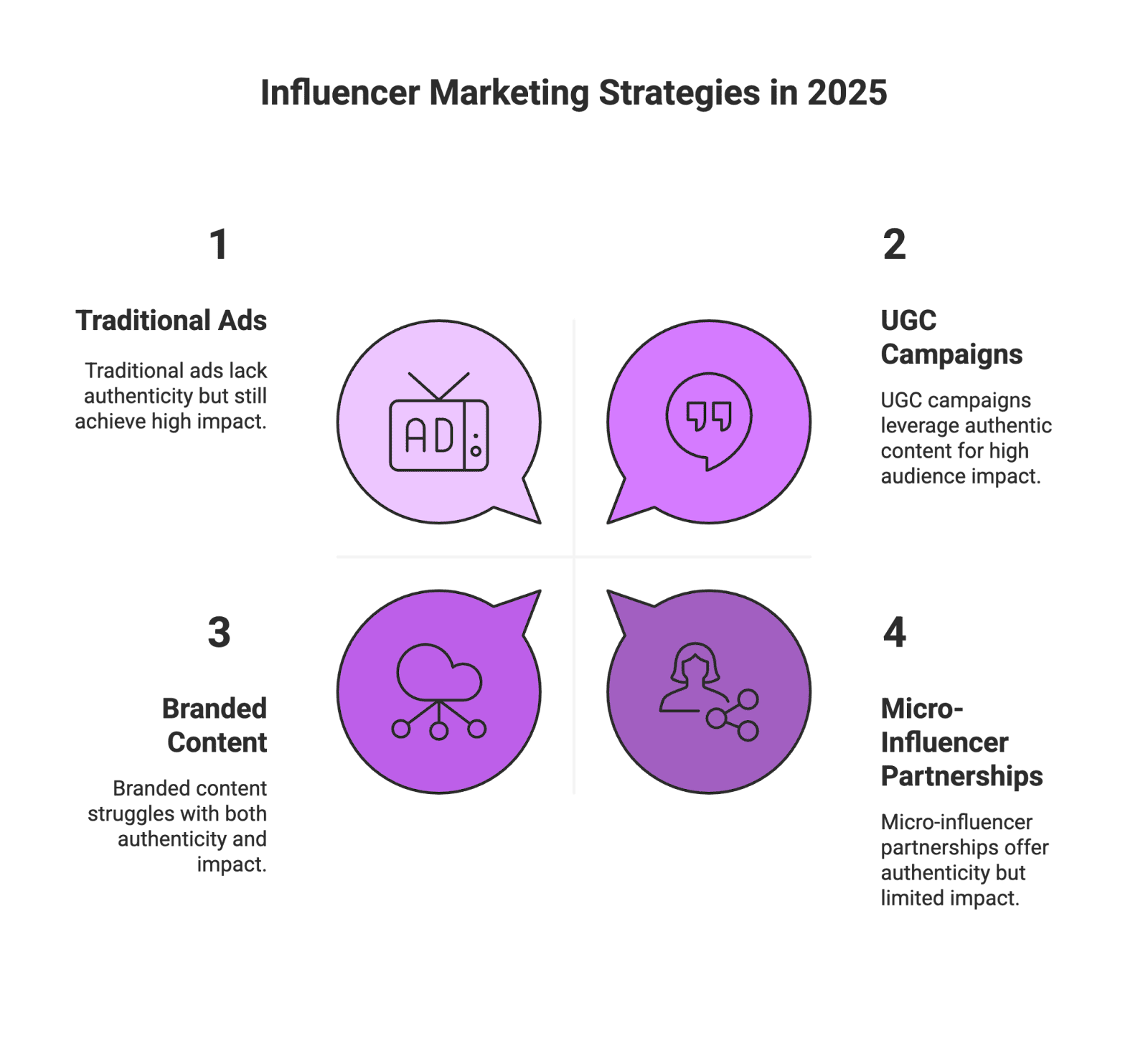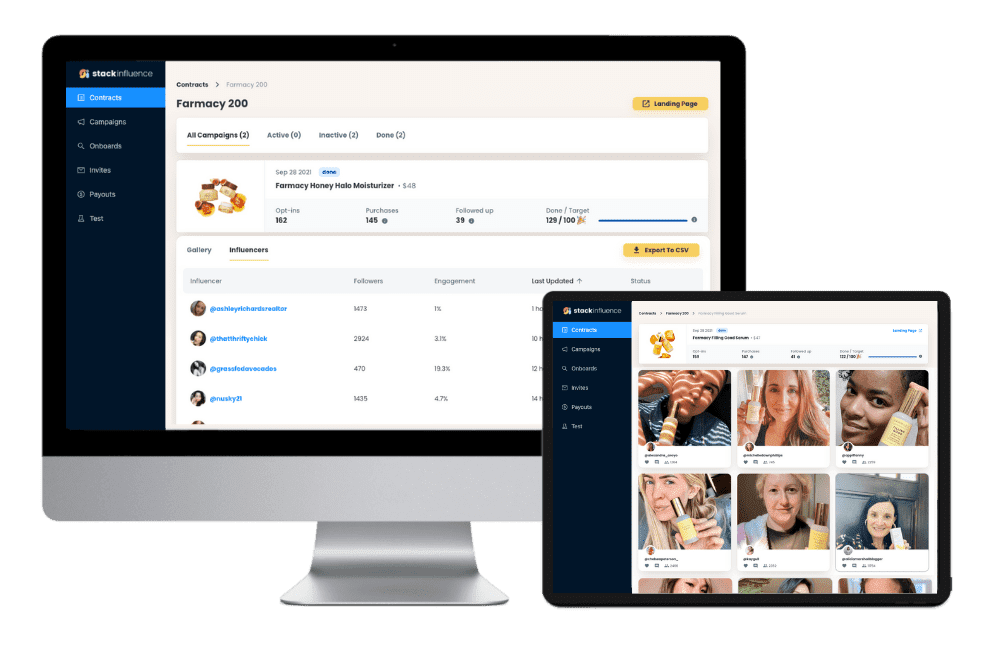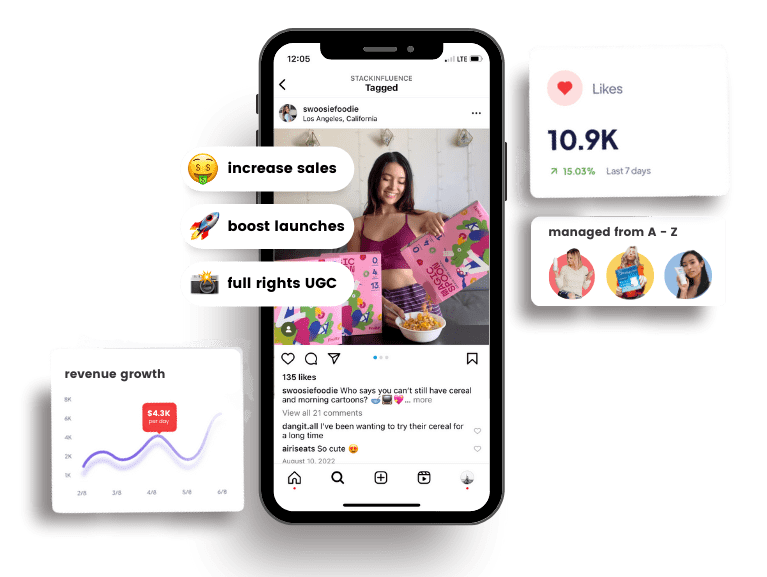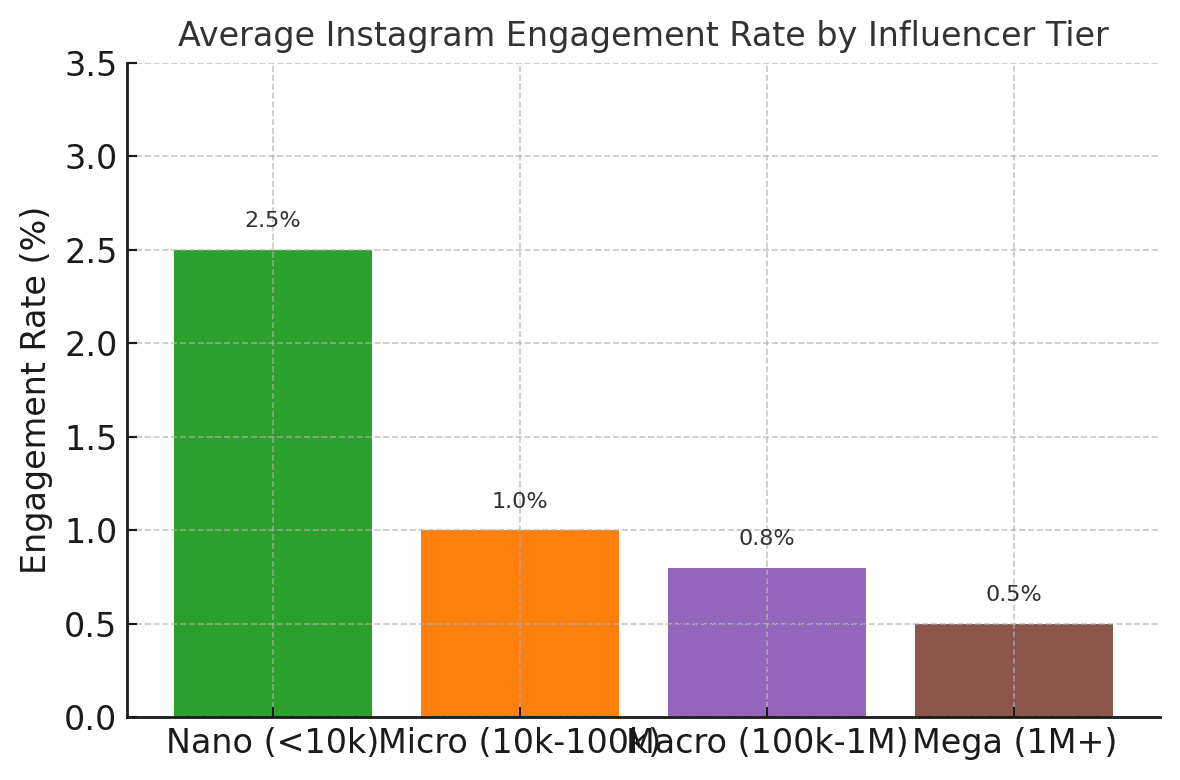Why CPG Brands Need Influencer Marketing in 2025
14th
August, 2025
Influencer Marketing
Amazon Marketplace
Artificial Intelligence
TikTok Tips
Consumer packaged goods (CPG) brands are at a crossroads in 2025. Traditional advertising is getting pricier and less impactful, while digital shoppers scroll past polished brand ads without a second glance. Enter influencer marketing – once a novel experiment, now a powerhouse strategy driving serious ROI for everything from indie Amazon sellers to Fortune 500 food and beverage companies. In fact, influencer collaborations have shifted from “nice-to-have” to an essential ingredient in CPG marketing. Consider that global influencer marketing spend is projected to hit $32.5 billion in 2025, up from just $6.5 billion in 2019. That explosive growth underscores a simple truth: if CPG brands want to stay relevant, they need to embrace the creator economy.

Figure: Global Influencer Marketing Industry Growth (estimated market size). The influencer marketing industry has soared from under $10 billion in 2019 to over $30 billion in 2025, reflecting how brands now view influencer campaigns as a core marketing channel rather than a fringe experiment. CPG brands are among the many jumping on this trend, as social media becomes the new “main street” for engaging shoppers.
So, why exactly do CPG brands need influencer marketing in 2025? Let’s break down the key reasons – from the unparalleled trust influencers command, to the surge in e-commerce and Amazon-focused strategies, to the treasure trove of user-generated content (UGC) they create. Along the way, we’ll see how tapping micro influencers and content creators can give CPG marketers an edge. (Spoiler: It’s not just about chasing likes – it’s about driving real product sales and brand love.)
1. Authentic Trust and Social Proof Win Consumers
Today’s consumers, especially Gen Z and millennials, trust influencers more than traditional ads. CPG shoppers want authenticity – real people showing real-life uses of a product – not just a glossy TV commercial. Influencers provide that relatable voice. In fact, 69% of consumers trust influencer recommendations (even if they don’t know the influencer personally) and younger generations increasingly turn to creators for product advice. CPG brands are relying on influencer marketing to boost awareness and sales because it meets the buying preferences of these digital-native shoppers. When a favorite fitness YouTuber raves about a new protein snack or a TikTok mom shows off a fun kids’ cereal, followers pay attention in a way they simply don’t with banner ads.
Influencer marketing is essentially digital word-of-mouth, and few things are more powerful in driving purchase decisions. A recommendation from a trusted creator feels like advice from a friend. As Barbara Mugica of Colgate-Palmolive put it, “Influencers can do a job no other marketing touchpoint can deliver.” That kind of credibility is gold for CPG brands fighting for shelf space (virtual or physical). Especially in an era when 34% of shoppers make online purchases at least once a week, a steady drumbeat of positive chatter from influencers can keep a brand top-of-mind. It’s no surprise a recent study found 49% of social commerce shoppers are swayed by influencer recommendations – proof that an authentic TikTok or Instagram post can directly translate into sales.

Unlock the Power of Micro Influencers and Elevate your Brand Today!

2. Higher ROI Through Micro Influencers and Niche Communities
Another big reason CPG companies are doubling down on influencers: it delivers bang for the buck. Traditional ads (TV spots, glossy magazine spreads) are expensive and scattershot. Influencer campaigns, on the other hand, can be highly targeted and cost-effective – particularly when working with micro and nano influencers. These are smaller-scale content creators (anywhere from a few thousand to ~100K followers) who often focus on specific niches. They may not be celebrities, but **micro influencers and nano influencers typically have outsized engagement and conversion rates relative to their size. Because their audiences trust them as genuine peers, a recommendation from a micro influencer can spur more action than a generic ad blast to millions.
Critically, partnering with micro/nano influencers can yield a higher ROI without breaking the bank. Many of these creators are affordable – sometimes they’ll promote a product for just a free sample or a modest fee – yet they drive real results. Surveys show over 70% of brands are now working with smaller creators and reporting strong outcomes. It makes sense: brands get $4+ in earned media value for every $1 spent on influencer marketing on average, and that number can be even higher with a savvy micro-influencer strategy (since smaller creators often charge less but engage more). In 2025, 73% of companies prefer to work with micro and mid-tier influencers for their superior engagement-to-cost ratio. Simply put, it’s a marketer’s dream: spend less, get more.

Figure: Smaller influencers (nano- and micro-influencers) tend to have higher average engagement rates on social media compared to macro- and mega-influencers. For example, a nano influencer with under 10k followers might see ~2–3% of their followers engage with a post, roughly double the engagement rate of a typical macro influencer with hundreds of thousands of followers.
These higher engagement rates mean that when a micro influencer posts about a new snack or skincare item, a larger share of their tight-knit community actually likes, comments, and clicks. And higher engagement often leads to higher conversion – if 2–3% of a nano influencer’s audience is motivated enough to interact, that’s a lot of potential buyers relative to a mega-star influencer whose audience might scroll past. No wonder brands report that nano influencers can even yield higher aggregate ROI when you crunch the numbers, thanks to their low costs and loyal followings. One data point: recent campaigns found nano-influencer promotions delivered a cost-per-click ~42% lower than micro-influencer campaigns – meaning cheaper traffic and more eyeballs for the same spend. The only catch? Managing dozens of small influencers can be labor-intensive (we’ll get to solutions for that later). But in terms of ROI, the math is compelling for CPG marketers.
3. Endless Content Creation (UGC) for E-Commerce and Ads
In 2025, content is king – especially authentic, user-generated content (UGC) that brands can repurpose across their marketing. Influencer campaigns conveniently double as continuous content engines. Each creator delivers photos, videos, unboxings, tutorials, you name it, featuring your product in real-life use. For CPG brands hungry for social media posts, product demo videos, and customer testimonials, this is a windfall. Instead of staging expensive photoshoots, you can quickly amass a library of influencer-generated content to fuel your Instagram, TikTok, YouTube, and even Amazon product listings.
This matters because UGC is incredibly effective at driving conversions. People want to see real customer experiences – it’s social proof. According to a Bazaarvoice report, 84% of consumers trust a brand’s marketing more if it features UGC. And when UGC is included along the online purchase path, conversions can increase by about 10% on average. Even paid ads perform better with UGC: ads featuring real user content get 4x higher click-through rates and a 50% lower cost-per-click compared to traditional ads. That’s huge for CPG brands operating on slim margins – your ad dollars simply work harder when the creative is a genuine customer-style post rather than a polished studio shot.
Influencers essentially act as both brand ambassadors and content creators. Let’s say you send free samples of a new protein bar to 50 micro influencers on Instagram. In return, you might get 50 unique pieces of content: reviews, recipe videos, lifestyle pics of people enjoying the bars on a hike, etc. Now you have a trove of material to share on your own channels or even use in e-commerce. Many brands will take the best influencer photos and add them to their product pages or Amazon listings as a form of visual review. This not only looks great but builds trust with shoppers browsing online. In a real-world example, one Amazon-focused brand’s nano-influencer campaign yielded 50+ posts and a wave of new product ratings and Q&A on their Amazon listing, all from a one-time product seeding effort. The brand ended up with “a trove of user-generated content and authentic testimonials to leverage in future marketing”. For a CPG marketer, that’s hitting the jackpot – you’ve turned a marketing campaign into long-lasting digital assets.
4. Reaching Shoppers on Amazon and Social Commerce Platforms
Speaking of Amazon – influencer marketing has become a secret weapon for Amazon sellers and D2C e-commerce brands. CPG products (think supplements, snacks, beauty creams, home cleaners, etc.) are hugely popular on marketplaces like Amazon. But competition is fierce, and getting your product discovered and well-reviewed is a major hurdle. Influencers can help crack that code. By driving their followers to your Amazon product page via referral links or promo codes, an influencer can boost your sales rank and visibility within Amazon’s algorithm, creating a virtuous cycle of more sales and reviews. Unlike traditional Amazon PPC ads (which have been getting costly), influencer traffic often comes at a lower CPC and with the bonus of built-in endorsement. Brands have found that an army of micro influencers talking up a product can lead to a steady flow of highly qualified buyers clicking “Add to Cart” – many of whom also leave positive reviews after purchase, further strengthening your product’s standing.
Influencers also shine in the realm of social commerce, which exploded recently with features like Instagram Shopping and TikTok Shop. Platforms now let users buy products directly through in-app links during an influencer’s post or livestream. CPG brands are leaning into this: one reason in-app purchases have skyrocketed on TikTok Shop is that it pairs perfectly with influencer content. For example, a beauty influencer’s livestream demoing a new face cream can feature a one-click purchase pop-up – blending content and commerce seamlessly. If your CPG brand isn’t leveraging creators in these social shopping environments, you risk missing out on a fast-growing sales channel.
And let’s not forget emerging programs like the Amazon Influencer Program, where influencers curate their own Amazon storefronts and livestreams featuring products they recommend. It’s yet another avenue where CPG brands can gain exposure through creator partnerships, effectively tapping into the influencer’s following as a pre-warmed audience. The bottom line is that in 2025, social media and e-commerce have merged – shoppers see a product on their feed and expect to buy it in a few clicks. Influencers are the linchpin driving that discovery-to-purchase journey. CPG brands need them to ensure their product is the one trending on TikTok or featured in that YouTuber’s “favorites” video, instead of gathering dust in a warehouse.
5. Staying Competitive and Culturally Relevant
Finally, let’s zoom out: why do CPG brands need influencer marketing, rather than just “could benefit from” it? Because in 2025, if you’re not visible on social media feeds, you practically don’t exist to a huge segment of consumers. Brands that stick solely to old-school marketing are losing ground to more agile, culturally tuned-in competitors who show up in the influencer space. Being part of the social conversation via creators keeps a CPG brand relevant and top-of-mind. Whether it’s a viral TikTok challenge featuring your product (remember the 2021 Ocean Spray juice skateboarder meme?) or a slew of Instagram reels showing recipes with your new sauce – those social moments drive real-world sales spikes and brand heat.
Influencer marketing also allows CPG brands to tap into micro-trends and niche communities in a way mass advertising can’t. For example, a gluten-free snack company can partner with dozens of gluten-free lifestyle micro influencers, instantly plugging into a passionate community of consumers. Or a local craft beverage brand can work with regional foodie influencers to build hype in specific cities. This kind of targeted cultural connection is incredibly hard to achieve with traditional media buys. In short, influencers give CPG marketers agility and specificity – you can be hyper-relevant to each audience segment by choosing creators that genuinely get that group.
It’s also worth noting that influencer content often sparks two-way engagement (comments, shares, duets) that deepens brand loyalty. It’s not just broadcasting a message, it’s starting a conversation. For CPG brands aiming to build communities around their products (think fandoms for certain snacks or cult followings for beauty items), influencers are the community leaders who rally the fans. By 2025, many leading CPG companies see creators as extensions of their marketing team – the on-the-ground storytellers who make the brand feel human and approachable.

Unlock the Power of Micro Influencers and Elevate your Brand Today!

How to Make It Happen: Finding the Right Influencers (and Scaling Up)
By now, the “why” of CPG influencer marketing should be clear. The next question is “how” – especially for brands that might not have a dedicated influencer manager or the budget to hire an agency. The good news is that with influencer marketing booming, a whole ecosystem of tools and platforms has emerged to connect brands with creators and streamline campaigns. In fact, over 60% of brands use third-party platforms or tools to assist with influencer marketing. These range from marketplaces where you can browse and contact influencers, to full-service platforms that handle everything from outreach to payments.
For example, Stack Influence is a platform specifically geared toward scalable micro- and nano-influencer campaigns. Stack Influence “automates product seeding campaigns” and manages the end-to-end process of working with a large number of small creators. You provide your product and goals, and the platform finds suitable influencers (often on Instagram or TikTok), invites them, ships out products, tracks their posts, and compiles the results. Tools like this help manage the recruitment, tracking deliverables, and results in one dashboard, so a lean marketing team can coordinate dozens – even hundreds – of influencer collaborations with minimal headache. As noted earlier, services like Stack Influence exist “precisely so that small brands can scale up campaigns without scaling up headcount.” In other words, even a one-person CPG marketing team can run an influencer program that rivals big brands, by leveraging the right tech and process.
Of course, brands can also take a more DIY approach: start small, work with a handful of local influencers, and build relationships organically. The key is to set clear objectives and track results – whether that’s using unique coupon codes, Amazon Associates links, or simply monitoring for sales lifts during the campaign period. Thanks to modern analytics, it’s easier than ever to see the impact (e.g. use Google Analytics UTM links for D2C site traffic, or Amazon’s attribution for external traffic). Most brands find that once they execute a couple of influencer activations and see the needle move – be it a spike in sales, a jump in web traffic, or a flood of positive reviews – they quickly ramp up budget for this channel. In fact, 80% of brands maintained or increased their influencer marketing budgets in 2025, with nearly half increasing spend by over 10%. The investment flows to where the returns are.
Conclusion to Why CPG Brands Need Influencer Marketing
Influencer marketing isn’t just a trend for CPG brands – it’s a paradigm shift in how consumers discover and decide on products. In 2025, micro influencers, content creators, and everyday customers wield more power over brand fortunes than million-dollar ad campaigns. They bring authenticity, trusted recommendations, and creative content that today’s shoppers crave. From bolstering your Amazon sales rank, to filling your social feeds with engaging UGC, to making your brand a part of cultural conversations, influencers truly tick all the boxes. And with so many tools and platforms (like Stack Influence and others) available to simplify campaign management, even resource-strapped brands can jump in and reap the benefits.
The CPG landscape is ultra-competitive, but partnering with influencers – big or small – is like hitting the turbo boost on your marketing. It’s word-of-mouth on steroids, it’s content creation crowdsourced, and it’s a direct line into the lifestyles of your target audience. Brands that embrace influencer marketing now are building the customer relationships and loyalty that will carry them through the next decade. Those that ignore it? They risk becoming irrelevant as consumers flock to the products they do see and hear about in their social streams.
At the end of the day, CPG brands need influencer marketing in 2025 because it delivers what traditional marketing increasingly can’t: authenticity at scale. When a foodie TikToker’s favorite hot sauce happens to be yours, or a skincare guru’s morning routine stars your face wash, that’s not just an ad – it’s a genuine endorsement money can’t buy (even though yes, you paid for it, but the audience doesn’t mind because it feels real!). So don’t sit on the sidelines. Identify the micro influencers in your niche, equip them with your awesome product, and let them work their magic. Your future customers are out there scrolling, and an influencer might be the one to introduce them to their next favorite CPG brand – make sure it’s yours.

By William Gasner
CMO at Stack Influence
William Gasner is the CMO of Stack Influence, he's a 6X founder, a 7-Figure eCommerce seller, and has been featured in leading publications like Forbes, Business Insider, and Wired for his thoughts on the influencer marketing and eCommerce industries.
Want new articles before they get published? Subscribe to our Awesome Newsletter.
stack up your influence
turning creativity into currency
our headquarters
111 NE 1st St, Miami, FL 33132
our contact info
[email protected]
stack up your influence
turning creativity into currency
our headquarters
111 NE 1st St, 8th Floor
Miami, FL 33132


